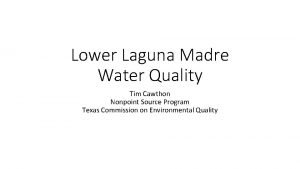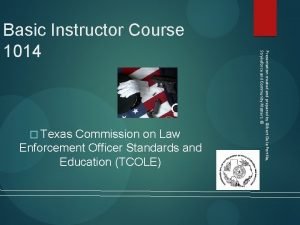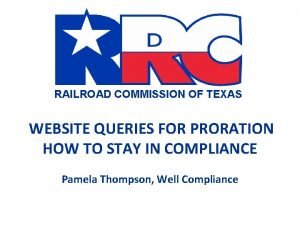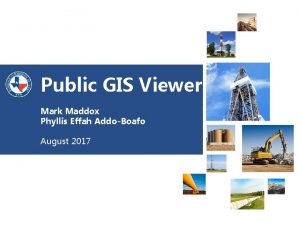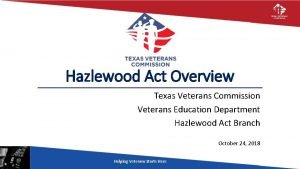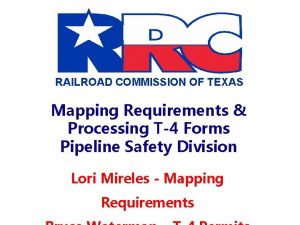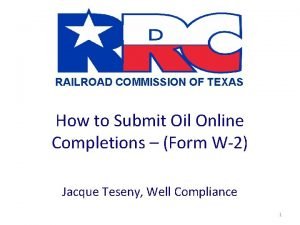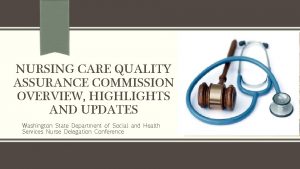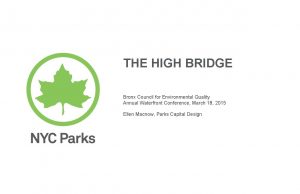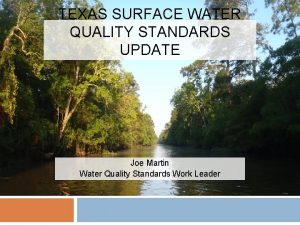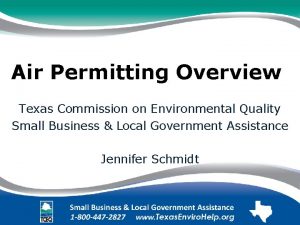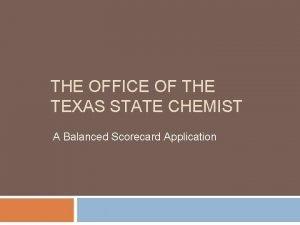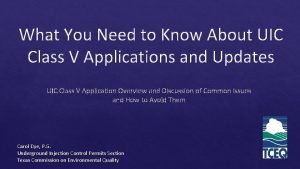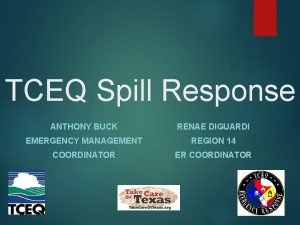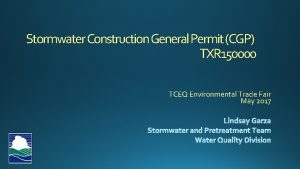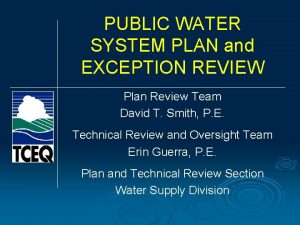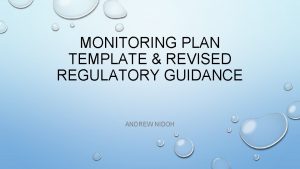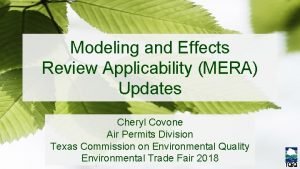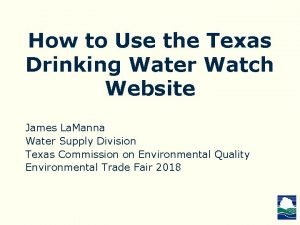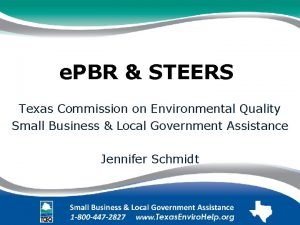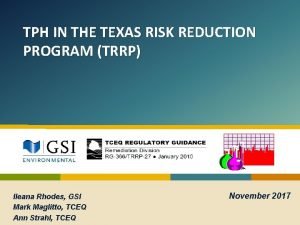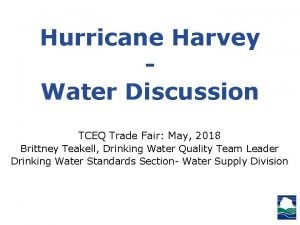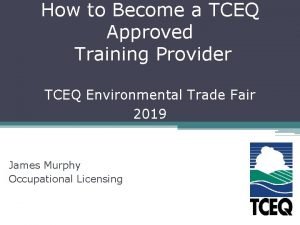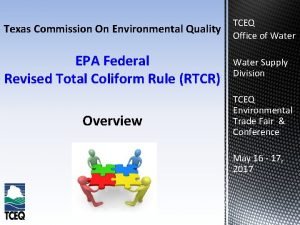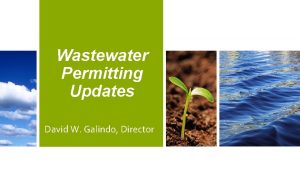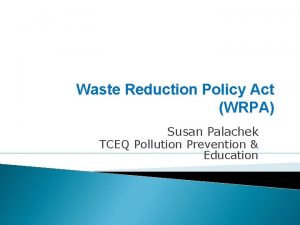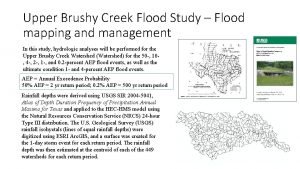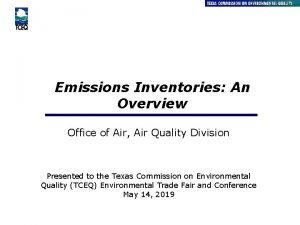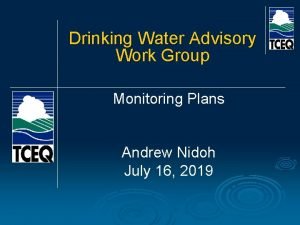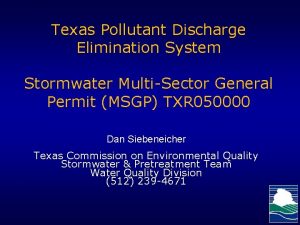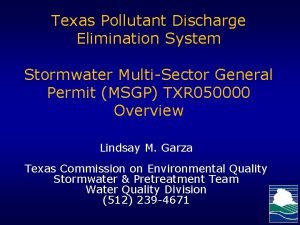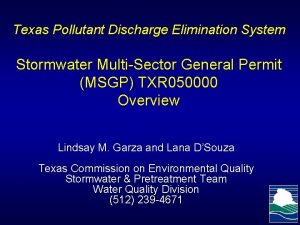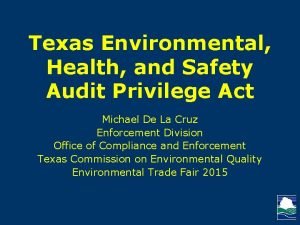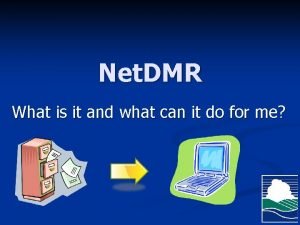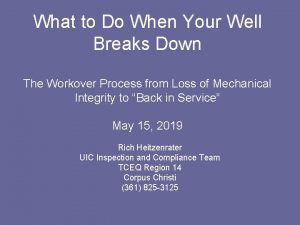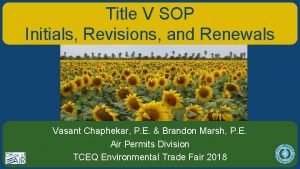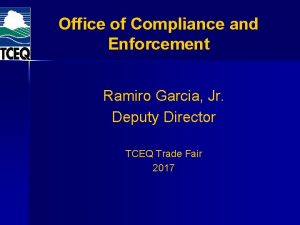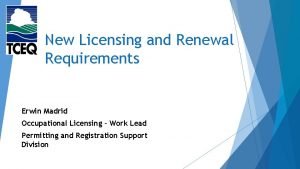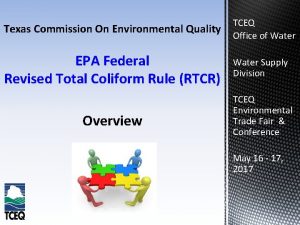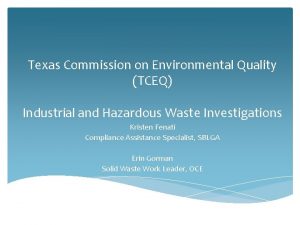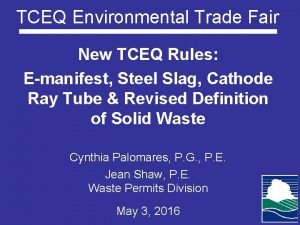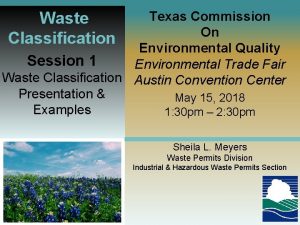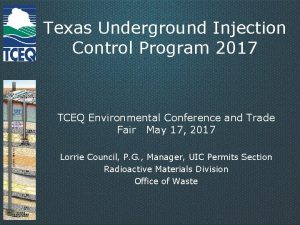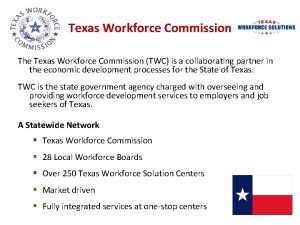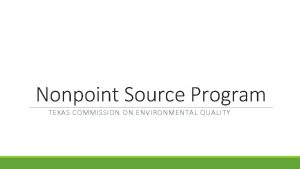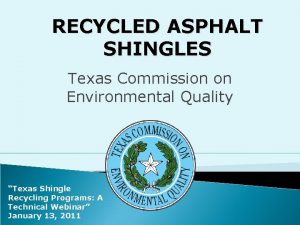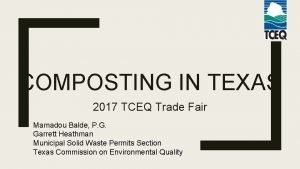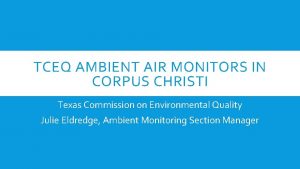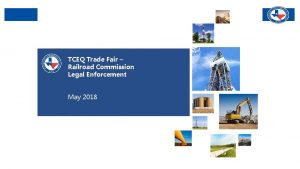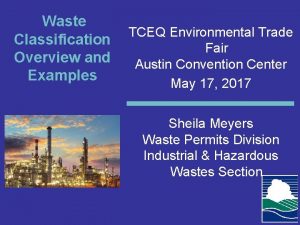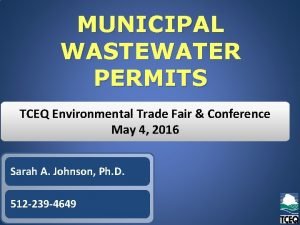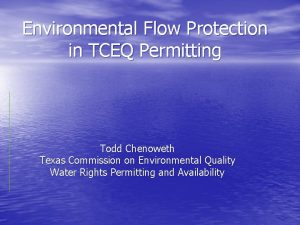Texas Commission On Environmental Quality TCEQ Office of
























































- Slides: 56

Texas Commission On Environmental Quality TCEQ Office of Water EPA Federal Revised Total Coliform Rule (RTCR) Water Supply Division Overview TCEQ Environmental Trade Fair & Conference May 16 - 17, 2017

TCEQ Public Drinking Water Section James Beauchamp, Special Assistant RTCR Rule Project Manager/RTCR Team Leader Water Supply Division/Drinking Water Standards Section James. Beauchamp@tceq. texas. gov or (512) 239 -6174 Additional contact information TCRDATA@tceq. texas. gov or DWAWG@tceq. texas. gov or (512) 239 -4691

Overview • 1. 0 - RTCR Introduction • 2. 0 - Sample Siting Plans • 3. 0 - Major Provisions – Routine/Repeat Sampling & SOPs • 4. 0 - Assessments and Corrective Action • 5. 0 - Elements of Assessments • 6. 0 - Nitrification Action Plans (NAP) • 7. 0 - Major Violations – E. coli MCL/TT/M&R/PN/BWN • 8. 0 - Key Points for Public Water Systems to Remember • 9. 0 - TCEQ Technical Assistance • 10. 0 - TCEQ Draft RTCR Rulemaking Timeline

1. 0 - RTCR Introduction The TCEQ has developed a new rule package in order to adopt the federal Revised Total Coliform Rule (RTCR) into Title 30 Title Texas Administrative Code (TAC), Chapter 290. The federal RTCR affects ALL Public Water Systems (PWSs) and was effective on April 1, 2016

1. 1 - RTCR Introduction The RTCR establishes: - a maximum contaminant level (MCL) for E. coli - a “find and fix” approach (assessments) to address fecal contamination that could enter into the distribution system - treatment technique violations for certain conditions The RTCR requires PWSs to: - develop a Sample Siting Plan that lists all routine/repeat and groundwater microbial sample sites and a sample schedule - perform assessments, identify sanitary defects (find), and take corrective action for any identified sanitary defects (fix) - complete and certify state-approved start-up procedures for seasonal public water systems

2. 0 - Sample Siting Plans Critical Deadlines and Requirements 40 CFR § 141. 853 • All PWSs must have developed a written Sample Siting Plan that identifies coliform sampling sites and a sample collection schedule that are representative of water throughout the distribution system by March 31, 2016. • PWSs must collect coliform samples at sites which are representative of water quality throughout the distribution system according to a written Sample Siting Plan. • Sample Siting Plans are subject to state review and revision.

2. 1 - Sample Siting Plans Critical Deadlines and Requirements 40 CFR § 141. 853 • Monitoring may take place at a: • customer's premise; • dedicated sampling station; or • designated compliance sampling location. • Sample Siting Plans must identify: • routine coliform sampling sites; • repeat coliform sampling sites; • sample collection schedule; • groundwater wells for compliance with the Ground Water Rule; and • if the wells are intended for use as a repeat monitoring site • Triggered Source Monitoring Plans (TSMP) submitted separately

2. 2 - Sample Siting Plans Critical Deadlines and Requirements Representative Sample Location Criteria At a minimum, PWSs should apply the following when selecting RTCR sample locations: • source locations; • treatment/including primary and booster disinfection facilities; • residual disinfectant levels; • hydraulic conditions, valve locations, water storage; • high, medium, and low water use areas; and • water age

2. 3 - Sample Siting Plans Critical Deadlines and Requirements Sample Siting Plan Map Requirements The Sample Siting Plan map must contain the following applicable location information: • “Routine” (OR) RTCR Sample Sites (Repeat sites not required); • Distribution water mains and sizes; • Entry Point Source Locations (e. g. , well source and/or surface water or groundwater under the influence (GUI) water treatment entry points into the distribution system, interconnection with other systems); • *Water Storage Facilities; • *Pressure Plane Boundaries. *If a system has only one pressure plane or does not have any water storage facilities, please indicate this information on the map.

2. 4 - Sample Siting Plan Map - Example

2. 5 - Sample Siting Plan - Template

2. 6 - Sample Siting Plan - Template

3. 0 - Major Provisions Routine Sampling 40 CFR § 141. 853 • PWSs must collect samples at regular time intervals throughout the month, except for: • PWSs that use only groundwater and serve 4, 900 or fewer people may collect all required samples on a single day if they are taken from different sites. • PWSs may take more than the minimum number of required monthly routine samples. • If so, PWSs must include the results of all samples in calculating whether a coliform treatment technique trigger has been exceeded only if the samples are taken in accordance with the Sample Siting Plan.

3. 1 - Major Provisions Routine Sampling All PWSs must take at least the minimum number of required routine samples even if: • The PWS has had an E. coli MCL violation • OR • has exceeded the coliform treatment technique triggers.

3. 2 - Major Provisions Routine Sampling PWSs that collect fewer than five routine samples per month (4, 100 or less population): • will no longer be required to conduct increased routine monitoring (5 samples) the month following a total coliform-positive month.

3. 3 - Major Provisions Repeat Sampling 40 CFR § 141. 853 RTCR (new) - Repeat Sampling Locations • PWSs must identify repeat monitoring locations in the Sample Siting Plan.

3. 4 - Major Provisions Repeat Sampling - Baseline Within 24 hours of learning of a TC+ routine sample result, all PWSs must collect at least 3 repeat samples and analyze them for total coliform One repeat sample must be collected from: • the same tap as the original sample • within five service connections upstream • within five service connections downstream

3. 5 - Major Provisions Repeat Sampling PWSs that collect only one routine sample per month (1, 000 or less population): • will no longer be required to collect 4 repeat samples for each coliform-positive sample.

3. 6 - Major Provisions Repeat Sampling • PWSs may propose alternative repeat monitoring locations that are expected to better represent pathways of contamination into the distribution system. • Requires a written – • Standard Operating Procedure (SOP) RTCR – 40 CFR § 141. 853(a)(5)(i)

3. 7 - Major Provisions Standard Operating Procedure PWSs may elect to specify either: • alternative fixed locations; or • criteria for selecting repeat sampling sites on a situational basis in an SOP in the PWS’s Sample Siting Plan. The PWS must design its SOP to focus the repeat samples at locations that best verify and determine the extent of potential contamination of the distribution system area based on specific situations. • The State may modify the SOP or require alternative monitoring locations as needed.

3. 8 - Major Provisions Standard Operating Procedure State Approval • The State may review, revise, and approve, as appropriate, alternative repeat monitoring locations proposed by PWSs. • PWSs must demonstrate that the Sample Siting Plan remains representative of the water quality in the distribution system. • The State may determine that entry point monitoring is effective to differentiate between potential source water and distribution system problems. (e. g. , Groundwater under the direct influence of Surface Water (GUI))

3. 9 - Major Provisions Repeat Summary All PWSs must continue to collect additional sets of repeat samples until either: • total coliforms are not detected in one complete set of repeat samples • OR • the system triggers an assessment. Note: If an assessment trigger is exceeded as a result of a routine samples being total coliform-positive, PWSs are required to conduct only one round of repeat monitoring for each total coliform-positive routine sample.

4. 0 – Assessments and Corrective Actions Level 1 and Level 2 Assessments The RTCR requires PWSs that have an indication of coliform contamination as a result of total coliform (TC) + samples OR E. coli MCL (EMCL) violations to assess the problem and take corrective action. TWO levels of assessments • Level 1 and Level 2 - based on the severity or frequency of the problem.

4. 1 - Assessments and Corrective Actions Purpose of Level 1 and Level 2 Assessments • To find Sanitary Defects at the PWS which: • could provide a pathway of entry for microbial contamination into the distribution system; OR • are indicative of a failure (existing or potential) of protective barriers against microbial contamination.

4. 2 - Assessments and Corrective Actions Examples of Sanitary Defects include but are not limited to: • inadequate Sampling Protocol or Sample Site inadequate treatment or maintenance of residual disinfection levels • low distribution system pressure • no backflow protection/cross-connection control • line breaks • deteriorated water storage facilities or infrastructure

4. 3 - Assessments and Corrective Actions Deadline for Completing Assessments 40 CFR § 141. 859 A PWS must complete and submit a Level 1 or Level 2 assessment form to the State within 30 days after the system learns that it has exceeded a trigger. • Level 1 and 2 assessments - PWSs must conduct or ensure that an assessment is conducted consistent with State requirements. • Level 2 assessments - PWSs must comply with any expedited actions or additional actions required by the State in the case of an E. coli MCL violation.

4. 4 - Assessments and Corrective Actions Deadlines for Completing Corrective Actions (1) Sanitary Defects identified during a Level 1 or Level 2 Assessment should be corrected as soon as possible. The PWS must complete corrective actions by one of the following timeframes: • No later than the time the assessment form is submitted to the state, which must be within 30 days of triggering the assessment, or • Within state-approved timeframe which was proposed by the PWS in the assessment form.

4. 5 - Assessments and Corrective Actions Deadlines for Completing Corrective Actions (2) 40 CFR § 141. 859 – Level 1 and Level 2 Assessments • The Assessment form may also note that no Sanitary Defects were identified. • The Assessment form must be completed and submitted to the State within 30 days even if no Sanitary Defects were identified.

4. 6 - Assessments and Corrective Actions Deadlines for Completing Corrective Actions (3) 40 CFR § 141. 859 • Consultation - At any time during the assessment or corrective action phase, either the PWS or the State may request a consultation with the other party to determine the appropriate actions to be taken. • The PWS may consult with the State on all relevant information that may impact on its ability to comply with a requirement, including the method of accomplishment and an appropriate timeframe.

4. 7 - Assessments and Corrective Actions Level 1 Assessment Who Conducts Level 1? • Performed by the PWS owner or operator each time a Level 1 Assessment is triggered. • Upon trigger of a Level 1 Assessment, the Level 1 Assessment form must be submitted to the state within 30 days.

4. 8 - Assessments and Corrective Actions Level 1 Assessment Triggers Level 1 Assessment is triggered if any one of the following occurs: • A PWS collecting fewer than 40 samples per month has 2 or more TC+ routine and repeat samples in the same month. • A PWS collecting 40 or more samples per month has greater than 5. 0 percent of the routine and repeat samples in the same month that are TC+. • A PWS fails to take every required repeat sample after any single TC+ sample.

4. 9 - Assessments and Corrective Actions Level 2 Assessment Who Conducts Level 2? • Performed by the State OR State-Approved Party each time a Level 2 Assessment is triggered. • The PWS may conduct Level 2 assessments if the PWS has staff or management with the certification or qualifications specified by the State unless otherwise directed by the State. • The PWS is responsible for ensuring that the Level 2 Assessment is conducted regardless of the entity conducting the Level 2 Assessment. • Upon trigger of a Level 2 Assessment, the Level 2 Assessment form must be submitted within 30 days to the state.

4. 10 - Assessments and Corrective Actions Level 2 Assessment Triggers Level 2 Assessment is triggered if any one of the following occurs: • A PWS incurs an E. coli MCL violation. • A PWS has a second Level 1 Assessment within a rolling 12 -month period, • unless the State has determined a likely reason that the samples that caused the first Level 1 treatment technique trigger were total coliform-positive and has established that the PWS has corrected the problem. • If the State determines that a PWS is not required to conduct a Level 2 assessment based on the occurrence of a second Level 1 A within a rolling 12 -month period, the PWS is still required to conduct an L 1 A. (40 CFR § 141. 859)

4. 11 - Assessments and Corrective Actions Example of Level 1 and Level 2 Assessor Qualifications • An understanding of the objectives and structure of the RTCR • Familiar with bacteriological sampling practices • A working knowledge of how to interpret: - Distribution system water quality data - Distribution system operational data - Source of supply data • An understanding of disinfection practices and treatment changes • Operator certification level appropriate to PWS type/size

4. 12 - Assessments and Corrective Actions Title 30 TAC § 290. 109(c)(3)(A)(i) – (iii) Level 1 and Level 2 Assessor Qualifications Level 1 and Level 2 assessments shall be conducted and completed by: • the PWS; • licensed operators as required under § 290. 46(e); or • other parties approved by the TCEQ. The PWS, licensed operators, and other parties approved by the TCEQ shall have also completed training as required by the TCEQ upon notice to the public water system in writing.

4. 13 - Assessments and Corrective Actions Other parties approved by the TCEQ include, but not limited to: • backflow prevention assembly testers and CSIs; • plumbing inspectors and water supply protection specialists; • licensed professional engineers (Tx Board of P. E. s); • circuit riders or technical assistance providers under contract with the TCEQ /or government agency approved by TCEQ; or • utility supervisor or manager supported by various utility staff or other individuals.

4. 14 - Assessments and Corrective Actions Title 30 TAC § 290. 109(c)(3)(A)(iii) § Assessors who have conducted Level 1 assessments which were determined by the executive director to be insufficient or inadequate may be required to complete additional training or obtain certifications as prescribed by the TCEQ.

5. 0 – Elements of Assessments Summary At a minimum, an ASSESSOR must ensure that the ASSESSMENT includes review and identification of: • Inadequacies in sample sites, sampling protocol, and sample processing • Atypical events that may affect distributed water quality or indicate that distributed water quality was impaired • Changes in distribution system Operations and Maintenance that may affect distributed water quality, including water storage • Source and treatment considerations that impact distributed water quality • Existing water quality monitoring data 40 CFR 141. 859(b)(2)

6. 0 – Nitrification Action Plans (NAP) § 290. 46. Minimum Acceptable Operating Practices for Public Drinking Water Systems. (z) Nitrification Action Plan (NAP). Any water system distributing chloraminated water must create a NAP. The system must create a written NAP that: • (1) contains the system-specific plan for monitoring free ammonia, monochloramine, total chlorine, nitrite, and nitrate levels; • (2) contains system-specific action levels of the above monitored chemicals where action must be taken; • (3) contains specific corrective actions to be taken if the action levels are exceeded; and • (4) is maintained as part of the system's monitoring plan in § 290. 121 of this title. Adopted November 18, 2015 Effective December 10, 2015

7. 0 – Major Violations E. coli Maximum Contaminant Level (MCL) Violation • A PWS will receive an E. coli MCL violation when there is any combination of an E. coli + sample result with a routine OR repeat Total Coliform + OR E. coli + sample result.

7. 1 - Major Violations E. coli Maximum Contaminant Level (MCL) E. coli MCL Violation Occurs with the Following Sample Result Combination Routine EC+ EC+ TC+ Repeat TC+ Any missing sample EC+ TC+ (but no E. coli analysis)

7. 2 - Major Violations E. coli Maximum Contaminant Level (MCL) Violation • Public Notice (PN) - An E. coli MCL violation requires a PWS to issue a PN under 30 TAC § 290. 122(a)(1) for acute violations or situations. • Boil Water Notice (BWN) - An E. coli MCL violation requires a PWS to issue a BWN under 30 TAC § 290. 122(a)(2)(A) for acute microbiological or turbidity violation.

7. 3 - Major Violations Treatment Technique Violation • Failure to conduct a Level 1 or Level 2 Assessment within 30 days of a trigger. • Failure to correct all sanitary defects from a Level 1 or Level 2 Assessment within 30 days of a trigger or in accordance with the state-approved timeframe. • Failure of a seasonal system to complete stateapproved start-up procedures prior to serving water to the public.

7. 4 - Monitoring(M) & Reporting(R) Violations TCR RTCR • Monitoring violations and Reporting violations will be tracked separately as 2 different violation types • Newly specified M/R violations: ‒ M - Failure to take every required routine or additional M&R routine sample in a compliance period. violation ‒ M - Failure to analyze for E. coli following a TC+ routine (tracked sample. together ‒ R - Failure to submit a monitoring report or completed as 1 assessment form after monitoring or conducting assessment violation correctly/timely. type) ‒ R - Failure to notify the state following an E. coli + sample. ‒ R - Failure to submit certification of completion of stateapproved start-up procedure by a seasonal system. 40 CFR 141. 204; 141. 860(c)-(d)

7. 5 - Public Notice for MCL-TT-M&R Violations TCR RTCR TC MCL violation/acute E. coli MCL violations (24 hours) MCL: FC+ or E. coli + Tier 1 Monthly TC MCL violation Treatment technique (TT) violations (30 days) Tier 2 Monitoring (Annual/or elevated to T 1 or T 2) Tier 3 Reporting (Annual/or elevated to T 1 or T 2) Tier 3 M&R (tracked as 1 violation type)

7. 6 - PN for L 1 and L 2 Recordkeeping Violation Public Notice for Failure to Maintain L 1 and L 2 Assessment Documentation • Recordkeeping - PWSs must maintain any assessment form and documentation of sanitary defects and corrective actions completed as a result of assessments for a period not less than five years after completion. (40 CFR § 141. 861(b) - RTCR) • Public Notice - PWSs must provide public notice for Reporting and Recordkeeping violations under the RTCR. (§ 141. 204(a) -Tier 3 Public Notice)

8. 0 - Key Points for PWSs • Adequately Assess your distribution system and routine/repeat microbial sample sites while developing your Sample Siting Plan to assist in reducing TC + and EC + sample results. • Find and correct sanitary defects as soon as you become aware of them: • to help reduce TC+ sample results, which may trigger a Level 1 Assessment. • to help reduce E. coli MCL violations, which trigger a Level 2 Assessment.

8. 1 - Key Points for PWSs Make sure to collect all routine and repeat samples as required Timely and correct monitoring can help reduce triggering a Level 1 or Level 2 Assessment because: • Failure to conduct repeat monitoring triggers a Level 1 Assessment. • A Level 1 Assessment triggered twice within a rolling 12 -month period triggers a Level 2 Assessment.

9. 0 - TCEQ Technical Assistance • TCEQ is providing training to TCEQ’s Financial, Managerial, and Technical (FMT) contractor concerning Level 1 assessment requirements. • TCEQ is making assistance available to PWSs that trigger a Level 1 assessment through TCEQ’s FMT contractor. • TCEQ is providing on-site technical assistance to PWSs that trigger a Level 2 assessment.

10. 0 - TCEQ Draft Rule Making Timeline • Public Comment Period-Start • Public Hearing Date/Time • Public Comment Period-End • Adoption Agenda • Rule Effective Date • Published in Texas Register October 7, 2016 November 22, 2016 March 8, 2017 March 30, 2017 April 7, 2017 Chapter 290 rules are available on TCEQ Website at: https: //www. tceq. texas. gov/rules/indxpdf. html

Questions?

RTCR Information TCEQ’s RTCR Website http: //www. tceq. texas. gov/goto/RTCR Or Search: TCEQ RTCR

RTCR Information EPA’s RTCR Guidance can be found at: http: //water. epa. gov/lawsregs/rulesr egs/sdwa/tcr/regulation_revisions. cf m

TCEQ Water Supply Division James Beauchamp, Special Assistant - Drinking Water Standards Section RTCR Rule Project Manager/RTCR Team Leader James. Beauchamp@tceq. texas. gov or (512) 239 -6174 Gary Chauvin, Manager - Drinking Water Standards Section Gary. Chauvin@tceq. texas. gov or (512) 239 -1687 Joel Klumpp, Manager - Plan & Technical Review Section Joel. Klumpp@tceq. texas. gov or (512) 239 -4453 Michele Risko, Manager - Drinking Water Special Functions Section Michele. Risko@tceq. texas. gov or (512) 239 -1689 Additional contact information TCRDATA@tceq. texas. gov or DWAWG@tceq. texas. gov or (512) 239 -4691

TCEQ Public Drinking Water Standards Section RTCR Contacts Jasmine Oliveira, RTCR Compliance Officer Drinking Water Quality Team Jasmine. Oliveira@tceq. texas. gov or (512) 239 -6141 Nicole Larison, RTCR Compliance Officer Drinking Water Quality Team Nicole. Larison@tceq. texas. gov or (512) 239 -6105

TCEQ Office of Water James. Beauchamp@tceq. texas. gov TCRDATA@tceq. texas. gov DWAWG@tceq. texas. gov Water Supply Division TCEQ Environmental Trade Fair & Conference May 16 - 17, 2017
 Tceq integrated report
Tceq integrated report Mudaliar commission is also known as
Mudaliar commission is also known as Graduated commision
Graduated commision Texas commission on law enforcement
Texas commission on law enforcement Trrc query
Trrc query Rrc public gis viewer
Rrc public gis viewer Texas veterans commission hazlewood
Texas veterans commission hazlewood Texas railroad commission pipeline permits
Texas railroad commission pipeline permits Texas railroad commission online queries
Texas railroad commission online queries Wireless health
Wireless health Washington medical quality assurance commission
Washington medical quality assurance commission Nursing quality assurance commission
Nursing quality assurance commission Nursing quality assurance commission
Nursing quality assurance commission Trainee european commission
Trainee european commission Edexcel controlled assessment
Edexcel controlled assessment Bronx council for environmental quality
Bronx council for environmental quality Ldeq
Ldeq Texas surface water quality standards
Texas surface water quality standards Tceq de minimis
Tceq de minimis Office of texas state chemist
Office of texas state chemist Quality assurance vs quality control
Quality assurance vs quality control Quality control vs quality assurance pmp
Quality control vs quality assurance pmp Pmp gold plating
Pmp gold plating Ana model of quality assurance
Ana model of quality assurance Compliance vs quality
Compliance vs quality Basic concepts of quality assurance
Basic concepts of quality assurance David a garvin 8 dimensions of quality
David a garvin 8 dimensions of quality Crosby's fourteen steps to quality improvement
Crosby's fourteen steps to quality improvement What is tqm
What is tqm Tceq central registry
Tceq central registry Drinking water watch
Drinking water watch Anthony buck
Anthony buck Tceq stormwater construction general permit
Tceq stormwater construction general permit Tceq wud
Tceq wud Rg384
Rg384 Tceq mera guidance
Tceq mera guidance Texas drinking water watch
Texas drinking water watch Tceq steers
Tceq steers Trrp pcls
Trrp pcls Tceq trade fair
Tceq trade fair Tceq training
Tceq training 30 tac 290
30 tac 290 Tceq water rights
Tceq water rights Natalia galindo memes
Natalia galindo memes Tceq p2 annual progress report
Tceq p2 annual progress report Tceq
Tceq Tceq
Tceq Tceq monitoring plan template
Tceq monitoring plan template Tceq multi sector general permit
Tceq multi sector general permit Tceq multi sector general permit
Tceq multi sector general permit Sic codes
Sic codes Tceq audit privilege act
Tceq audit privilege act Tceq netdmr
Tceq netdmr Tceq region 14
Tceq region 14 Tceq central file room online
Tceq central file room online Tceq organization chart
Tceq organization chart Renewal
Renewal
